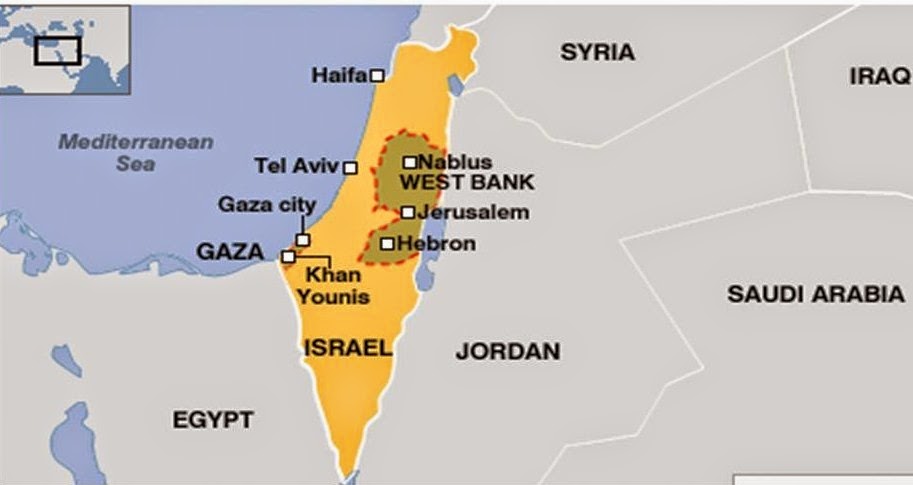This is the first of the Gaza Explainers.
What is Palestine?
Palestine, almost entirely populated by Muslims, comprises
two major chunks of territory: West Bank and Gaza Strip.
 West Bank
West Bank
At 3,620 sq. km., West Bank is the larger of the two Palestinian
territories. The territory has a population of 2.44 million, with an additional 2.6 lakh Israeli settlers.
West Bank, located between Israel and Jordan, was occupied by Israel
in the 1967 Six-Day War.
Currently, West Bank is under the control of Palestinian Authority (PA), which
is a direct political rival of Hamas.
Gaza Strip
Gaza Strip is a narrow stretch of land (of about 360 sq. km.) located
between Israel and Mediterranean Sea, with Egypt on the south. It has an estimated population of 16 lakh. Occupied by Israel in the 1967 Six-Day War, Gaza is controlled by Hamas.
Is Palestine an
independent country?
No. Let’s put it this way. Palestine is more of a territory
fighting for independence from Israeli occupation of some parts of its
territory. Palestine is not sovereign in the true sense of the term; large
swathes of its territory are controlled by Israel, including within the West
Bank, where there are Jewish settlements.
What about Hamas?
In 1987, radical Islamist Sheikh Ahmed Yassin founded Hamas, an acronym of
the Harakat al-Muqawama al-Islamaiyya (Islamic Resistance Movement).
The birth of Hamas can be attributed to the aspirations of
extremist Palestinians to build a movement like Hezbollah, an extremist Shia
Muslim outfit which operates out of Lebanon.
These extremist elements felt that
there should be a similar home-grown Sunni movement, i.e., one that would
operate from Palestinian soil.
What does Hamas think
about Israel?
Hamas does not recognise the existence of Israel. In fact, Hamas denies the
latter’s right to exist. One unique feature of Hamas is that it lays great
emphasis on religion, which is in serious contrast to the secular Fatah party,
which rules the West Bank.
Hamas’ charter explicitly mentions that the fundamental aim
of its existence is the destruction of the State of Israel and the
establishment of a sovereign Palestine.
In short, Hamas is a
radical Sunni extremist group, which is anti-Israel and one which is fighting
for an independent, sovereign Palestine.
Who supports Hamas?
From its inception and till recently, Hamas was funded by Iran
and Syria and a range of Islamic charities, many of which are listed as fronts
for Islamic terror groups, and are hence banned in many countries of the world.
The irony is that both
Iran and Syria are controlled by Shia Muslims while Hamas is a radical Sunni
Islamist organisation. Iran and Syria also do not recognise the State of Israel;
Iran has repeatedly called for ‘wiping Israel off the map of the world’.
However, since the beginning of the civil war in Syria a lot
has changed in the political equations involving Hamas.
For several years, Hamas ran a major office in the Syrian
capital, Damascus. However, the deeply sectarian conflict in Syria has impacted
the Hamas-Iran-Syria equation as well.
As the Sunni rebel movement against the Shia ruling
dispensation gathered pace, Hamas, a Sunni radical group, found itself in a
difficult situation. In this sectarian conflict, Hamas’ natural sympathies lay
with the Sunni rebels in Syria. Unable to digest the fact that its principal
backers, Syria and Iran, are waging a relentless campaign against Sunni rebels,
Hamas moved out of Damascus. It is also believed that Hamas was forced to move out
of Damascus by the Syrian regime itself.
Hamas shifted base to Doha, capital of Qatar, a Sunni
kingdom. Qatar is stridently anti-Iran and anti-Syria (read anti-Bashar).
Today, Qatar has emerged as the principal political and financial backer of
Hamas.
More short Explainers on the Gaza Crisis to follow.








